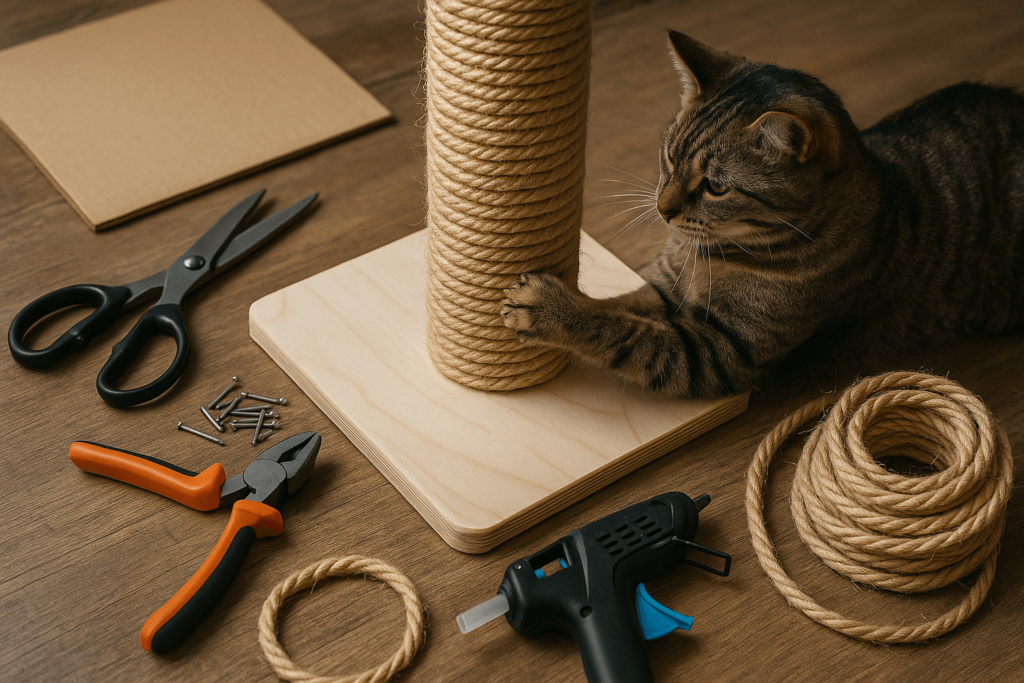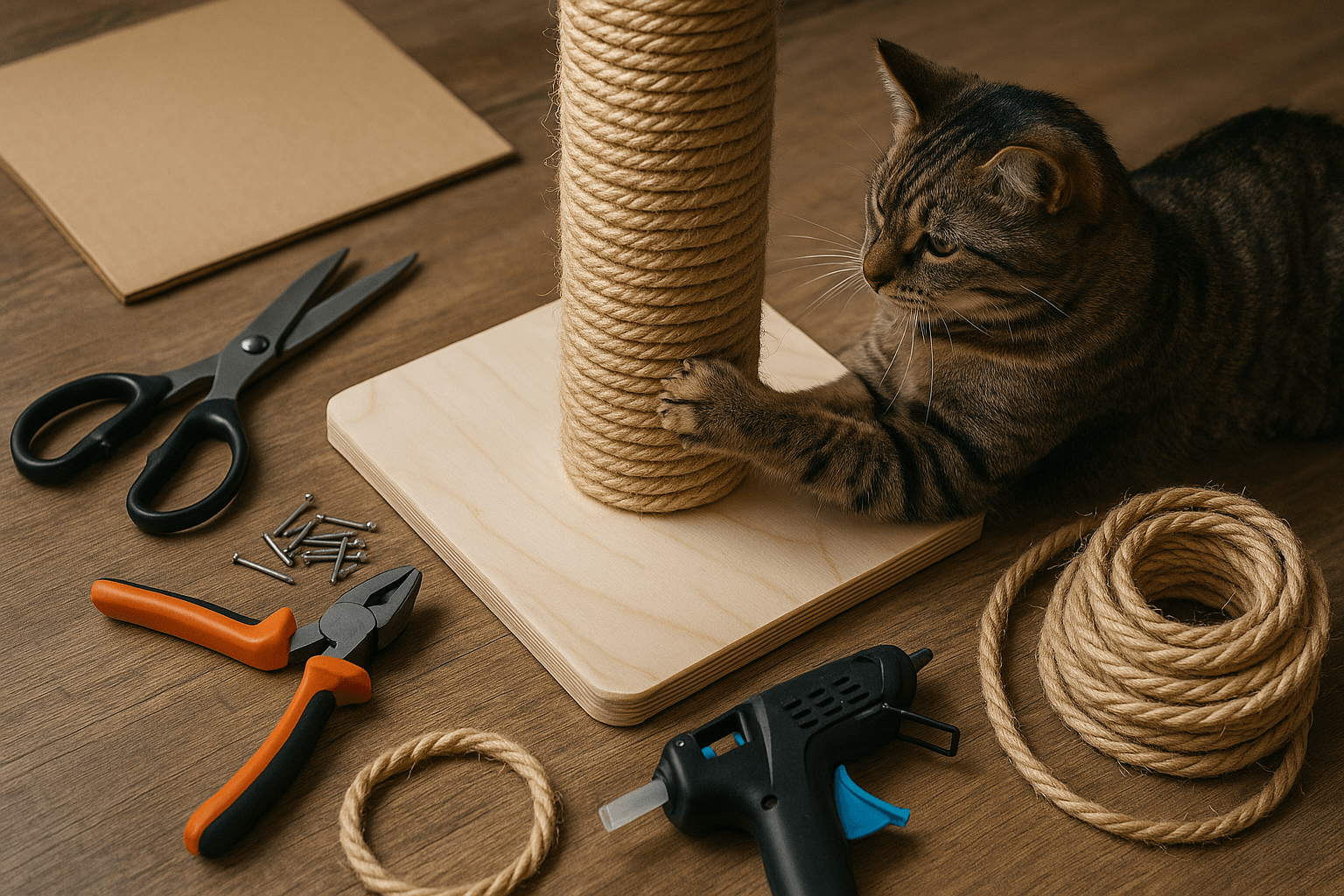Cat Scratch Post DIY: Build the Perfect Scratching Solution for Your Feline Friend
Cats are naturally inclined to scratch—it’s an instinctive behavior that helps them stretch, sharpen their claws, and mark their territory. However, this natural habit can lead to unwanted damage to your furniture, carpets, and curtains. A cat scratch post is an excellent solution to redirect their scratching instincts while keeping your home intact. The good news? You don’t need to spend a fortune on store-bought options. With a little creativity and some basic materials, you can create a custom DIY cat scratch post that suits your cat’s preferences and your home decor. Let’s dive into how you can build the perfect scratching post for your furry companion.
Essential Materials for Your DIY Cat Scratch Post
Before you start building, gather all the necessary materials to ensure a smooth and successful project. Here’s what you’ll need to create a sturdy and appealing cat scratch post.
Wooden Posts or Planks:
Choose untreated wood for vertical posts or horizontal platforms. Ensure it’s thick enough to withstand vigorous scratching.Sisal Rope:
Sisal is durable and provides excellent texture for cats to sink their claws into. It’s also affordable and easy to work with.Cardboard or Carpet Scraps:
These materials are great alternatives for horizontal scratch pads or additional surfaces on the post.Base Platform:
A wide, sturdy base (like plywood) ensures stability and prevents the post from tipping over during use.Non-Slip Pads or Adhesive Feet:
Attach these to the bottom of the base to prevent sliding on smooth floors.
With these materials in hand, you’ll be well-prepared to construct a functional and attractive scratching post tailored to your cat’s needs.

Step-by-Step Guide to Building Your Cat Scratch Post
Creating a DIY cat scratch post is easier than you might think. Follow these steps to assemble a sturdy and engaging scratching solution for your feline friend.
Prepare the Base:
Cut a piece of plywood into a square or circular shape. Sand the edges to prevent splinters and ensure a smooth finish.Attach the Vertical Post:
Secure a wooden post to the base using screws or strong adhesive. Make sure it stands upright and doesn’t wobble.Wrap with Sisal Rope:
Start at the bottom and tightly wrap sisal rope around the post, securing it with hot glue as you go. Overlap slightly to avoid gaps.Add Horizontal Platforms (Optional):
Attach small shelves or platforms to the post for lounging. Cover these with carpet scraps or sisal for added scratching space.Stabilize the Structure:
Double-check the stability of the post by gently pushing it. Add non-slip pads to the base for extra security.
By following these steps, you’ll create a durable and inviting scratching post that your cat will love to use.
Check this guide 👉Why Do Cats Scratch Posts? Best 7 Expert Tips!
Check this guide 👉Why Is My Cat Scratching the Window? Best 7 Expert Tips!
Check this guide 👉Why Do Cat Scratches Itch? Best 7 Expert Tips!
DIY Cat Scratch Post Materials | Benefits of Each Material |
|---|---|
Wooden posts or planks | Provides a sturdy foundation for scratching |
Sisal rope | Durable texture cats love to scratch |
Cardboard or carpet scraps | Affordable and versatile alternatives |
Plywood base | Ensures stability and prevents tipping |
Non-slip pads or adhesive feet | Prevents sliding on smooth surfaces |
Tips for Customizing Your DIY Cat Scratch Post
Every cat is unique, so personalizing your scratch post can make it even more appealing to your feline friend. Consider these tips to tailor the design to your cat’s preferences.
Choose the Right Height:
Some cats prefer tall posts for full-body stretches, while others enjoy shorter ones for quick scratches. Adjust the height accordingly.Incorporate Multiple Levels:
Adding platforms or perches creates a multi-functional space for climbing and lounging.Experiment with Textures:
Combine sisal, carpet, and cardboard to offer variety and cater to different scratching styles.Add Toys or Bells:
Attach dangling toys or bells to encourage play and interaction with the post.Match Your Decor:
Use neutral-colored materials or paint the base to blend seamlessly with your home’s aesthetic.
Customizing your scratch post ensures it meets both your cat’s needs and your personal style preferences.
How to Encourage Your Cat to Use the Scratch Post
Even the best-designed scratch post won’t be effective if your cat ignores it. Use these strategies to entice your feline friend to embrace their new scratching solution.
Place It Strategically:
Position the post near your cat’s favorite sleeping spots or areas where they tend to scratch furniture.Use Catnip as a Lure:
Sprinkle catnip on and around the post to pique your cat’s interest and encourage exploration.Reward Positive Behavior:
Offer treats, praise, or playtime whenever your cat uses the post to reinforce the desired behavior.Make It Interactive:
Play with your cat near the post using wand toys or laser pointers to associate it with fun activities.Be Patient and Persistent:
It may take time for your cat to adjust to the new post. Avoid punishing them for scratching elsewhere; instead, redirect their attention to the post.
With patience and consistency, your cat will soon see the scratch post as their go-to spot for satisfying their natural instincts.
Benefits of DIY Cat Scratch Posts
Building your own cat scratch post offers numerous advantages beyond just saving money. Here’s why a DIY approach is worth considering.
Cost-Effective Solution:
DIY projects use affordable materials, making them much cheaper than store-bought alternatives.Customizable Design:
You can tailor the size, shape, and materials to perfectly match your cat’s preferences and your home decor.Eco-Friendly Option:
Repurposing old materials reduces waste and promotes sustainability.Bonding Opportunity:
Crafting a scratch post gives you a chance to engage creatively and show love for your pet.Improved Cat Behavior:
A well-designed post redirects destructive scratching habits, fostering harmony in your home.
A DIY cat scratch post is not just practical—it’s a win-win for you, your cat, and the environment.
Common Mistakes to Avoid When Building a Scratch Post
While building a DIY cat scratch post is straightforward, avoiding these common mistakes ensures a successful outcome.
Using Weak Materials:
Flimsy bases or thin posts can topple easily, discouraging your cat from using them.Skipping Stability Checks:
A wobbly post may scare your cat away. Always test the structure before introducing it.Overlooking Size Preferences:
Posts that are too short or narrow may fail to meet your cat’s scratching needs.Neglecting Texture Variety:
Cats enjoy different textures—if one material doesn’t appeal, include alternatives like sisal or carpet.Forgetting to Reinforce Edges:
Sharp edges or rough surfaces can harm your cat. Sand everything down for safety.
Avoiding these pitfalls will result in a durable and appealing scratch post your cat will love.
Fun Add-Ons to Enhance Your DIY Cat Scratch Post
Adding creative features to your DIY cat scratch post can make it even more enticing and enjoyable for your cat.
Hanging Toys:
Attach feathered toys or strings to stimulate play and keep your cat entertained.Built-In Hammocks:
Include a cozy hammock or cushioned platform for lounging and napping.Tunnels or Hideouts:
Incorporate tunnels or enclosed spaces where your cat can retreat and feel safe.LED Lights or Motion Sensors:
Add battery-operated lights or sensors to create interactive elements that captivate curious cats.Multi-Level Designs:
Build a multi-tiered structure with ramps, steps, or bridges for climbing and exploring.
These fun add-ons transform your scratch post into a dynamic playground that keeps your cat engaged and happy.
Frequently Asked Questions About DIY Cat Scratch Posts
What’s the best material for a cat scratch post?
Sisal rope is highly recommended due to its durability and texture, but cardboard and carpet are also popular alternatives.
How do I stop my cat from scratching furniture?
Provide appealing scratching alternatives like a DIY post and use deterrents like double-sided tape on furniture.
Can I use recycled materials for my DIY project?
Yes, items like old carpet scraps, cardboard boxes, and leftover wood are eco-friendly options.
How often should I replace the sisal rope?
Replace it when it becomes frayed or worn out, typically every few months depending on usage.
Is it safe to attach toys to the scratch post?
Yes, just ensure they’re securely fastened to prevent choking hazards or accidents.
Building a Scratch Post That Keeps Your Cat Happy and Your Home Safe
A DIY cat scratch post is a simple yet effective way to satisfy your cat’s natural scratching instincts while protecting your furniture and belongings. By choosing the right materials, customizing the design, and encouraging your cat to use it, you can create a solution that benefits both you and your feline companion. Not only does this project save money, but it also allows you to bond with your pet through thoughtful craftsmanship. So roll up your sleeves, gather your supplies, and get ready to enjoy a happier, scratch-free home!
Is Royal Canin Good Cat Food? Best 7 Expert Tips! Learn the truth about this brand & get vet-approved advice on feeding, ingredients, and tailored formulas.
Dwarf Cat Lifespan: Best 7 Expert Tips! Discover how to ensure a long, healthy, and happy life for your short-legged feline companion.
Blue Buffalo Cat Food: Best 7 Expert Tips! Discover how to choose the right formula, feeding strategies, and nutritional benefits for your feline friend.
Canned Pumpkin for Cat Diarrhea: Best 7 Expert Tips! Natural remedy to firm stools, soothe upset bellies, and support gut health safely.





